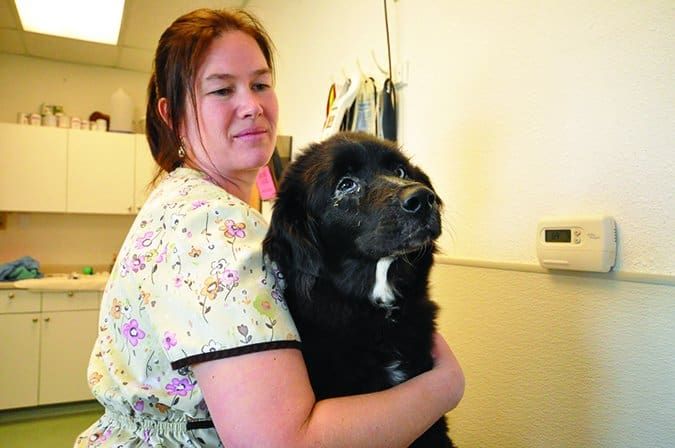As Frodo learned all too well, messing around with someone’s eye can be asking for trouble. And while administering ophthalmologic drops or ointment to your dog isn’t quite as hairy as tangling with the Red Eye of Sauron, it still can be an unpleasant experience for both of you if you are unprepared.
Eye drops and ointments are prescribed for a variety of ocular conditions in dogs, including glaucoma, corneal ulcers, and recovery from cataract surgery. Even a minor eye infection like conjunctivitis – what the kids in your grade-school days called “pink eye” – can require regular administration of drops.
But when it comes to putting anything in their eyes or those of their dogs, “people are naturally freaky about it,” says Dr. David Maggs, professor of veterinary ophthalmology at the University of California at Davis. “And it’s just difficult to aim: You’ve got a wriggly dog and a very small target.” It doesn’t help that eyes in need of medication tend to look very off-putting, to put it mildly: Even a superficial scratch of the cornea, which in many cases will resolve in a few days, can make your dog look like something out of a low-budget horror flick.

If you’re feeling trepidation, your dog probably isn’t looking forward to the experience, either. Most would rather be somewhere, anywhere, else rather than getting a generous splash of wetness plopped into their eye, which likely isn’t feeling so great to begin with. “Depending on the dog, they can be very sensitive, especially if they have ulcers in the eye, which are extremely painful,” says Dr. Tomas Infernuso, of Veterinary Traveling Surgical Services in Long Island, New York. “And they associate any kind of contact with pain.”
That said, there is something worse than having to deal with a dog’s resistance to getting eye medications: Having matters escalate to the point where you can’t give them at all. “I’ve seen dogs who have lost an eye because people couldn’t medicate them,” Dr. Infernuso says. And that’s really not an option.
Find a Technique That Works For You
Ask 10 veterinarians, and chances are that you’ll hear 10 different (and sometimes contradictory) recommendations on how best to give eye medications. The following are some tips to make the process a little smoother; pick the ones that work best for you and your dog.
Ask 10 veterinarians, and chances are that you’ll hear 10 different (and sometimes contradictory) recommendations on how best to give eye medications. The following are some tips to make the process a little smoother; pick the ones that work best for you and your dog.
Cornered! Dr. Brad Holmberg, a board-certified ophthalmologist at the Animal Eye Center in Little Falls, New Jersey, likes to position the dog so she can’t back away: For small dogs, that’s on a table or countertop, with the dog’s rear against you – “butt to belly,” as he puts it.
Dr. Holmberg recommends straddling large dogs (who need to stay on the floor) with your thighs and elbows, and maneuvering their backs into a corner so they have no way to escape.
“Place your left hand on their chin and angle their head up,” he explains. Rest your right hand on the dog’s forehead, with the applicator ready. Using the thumb of the left hand, which is still steadying the chin, pull up the eyebrow – not the eyelid – to expose the white of the eye, and apply the drops.
Less restraint. Dr. Infernuso, by contrast, prefers not to restrain the dog unduly. “I usually start by rubbing the dog on the head, so he knows I’m not just going for the eye,” he explains. “Then I gently massage the area around the eye,” being careful, of course, not to put any pressure on the eye itself.
Restraining a dog, he notes, usually will mean that she will resist you. “They learn that when they’re held, something’s going to happen, so it usually turns out to be more of a struggle than an easy way out, and usually you get the opposite of what you want.”
Instead, with most patients, he offers food with one hand and administers the medicine with the other. (In a variation of this, a dog rescuer recently exulted on Facebook that she had found the perfect distraction: peanut butter smeared inside a yogurt cup, then held high to induce a helpful head tilt.)
I’ll take Ointment. Dr. Infernuso prefers ointment, because it lasts longer, and administers it by using his thumb to pull down the bottom eyelid, then deposits the medication on the pink tissue, or conjunctival sac. “You don’t have to open the eye that much, and you don’t want to touch the cornea,” he says. He administers drops this way, too.
Going steady. Take a tip from the manicurist: If you’ve ever gone to a nail salon, you might have noticed that the technician stabilizes the hand she holds the nail-polish brush with by resting her pinky against the table; it gives her more control and accuracy. Use that same technique with the hand that holds the eye medication.
“Resting your hand on your dog’s head is important – you don’t want to be holding the bottle above his head,” says Dr. Jacqueline Pearce, an assistant professor of comparative ophthalmology at the University of Missouri in Columbia. “Hold the medicine bottle or tube with your thumb and forefinger, and rest your pinky on the dog’s forehead.” Use the fingers of your other hand to hold the dog’s eyelid open.
Don’t telegraph your plans. Dr. Pearce also advocates the element of surprise, bringing the bottle from behind. “Move your hand along the dog’s neck toward the back of the head,” she advises. “That’s better than if you come straight at them with the bottle.”

Hands Off. Administering eye medication is a tricky little dance: You have to get close enough to ensure that the liquid or ointment actually gets into the eye, but not so close as to let any portion of the applicator make contact with it. With eye drops, hold the applicator about an inch from the eye, and be conscious of where it is at all times. “I’ve seen people rupture the eye by holding it too close,” Dr. Infernuso warns, “or the dog turns his head and basically perforates the cornea.”
Though you might be tempted to squeeze ointment on to your finger before applying it, don’t: No matter how well you clean your hands, you will transmit bacteria into your dog’s eye. Again, with ointment you don’t apply it to the eye itself, but rather to the strip of pink tissue behind the eyelid. Once placed there, the ointment will dissolve and distribute itself across the eye.
Be Prepared. “Get your drops ready,” Dr. Holmberg says. “Remember to take the top off before you start.” To soften ointment so that is more viscous and easier to spread, put the tube under your armpit or in your pants pocket for five minutes. “It will be more like a gel than toothpaste,” he explains.
If you’re short on time, you can also run the ointment under warm tap water for a minute or so, Dr. Pearce adds. She notes that eye drops rarely have to be refrigerated, but if yours do – or if they have been in a cold car or storage area for any length of time – leave them out for ten minutes so they warm to room temperature. Overly cold liquid is uncomfortable for your dog.
Help wanted. If at all possible, have a capable helper on hand. One person can help support the head and body to keep the dog still, while the other person focuses on holding and administering the medication.
Accentuate the positive. “One thing that’s really helpful is to reward the dog after he gets eye drops, so he associates it with something positive,” says Dr. Pearce of the University of Michigan. “I’ve had clients who say their dogs remind them it’s time for their drops.”
Tough Customer?
Oh, to have a pliant and pleasant Lassie who lifts her comely head to you in trust and deference as you administer those all-important drops. But the reality is that some dogs are simply not willing to follow a script when it comes to medical procedures, and if you want to get the job done, some vets offer more compulsory methods to consider. This may go against your personal philosophy in handling your dog, but, as always, measure it against the potential repercussions of not being able to medicate at all.
Several veterinarians suggest giving the antihistamine Benadryl, which can have a subtle settling effect, about a half-hour before applying the eye medication. (The recommended dose is 1 milligram per pound of body weight.) Dr. Infernuso notes that because many eye conditions are painful, it can be appropriate to have the dog on some pain medication to manage that discomfort to begin with.
“Sometimes, a soft muzzle will preoccupy a dog” long enough for an owner to administer the medication, Dr. Pearce notes. And sometimes that kind of mouth restraint is required with dogs who may be unhappy or panicked enough to attempt to bite when the bottle draws near.
Dr. Holmberg notes that wrapping a small dog in a towel is sometimes very calming, though this may have more to do with the dog being immobilized rather than any more relaxed emotional state. Following this train of thought, consider using a pressure wrap such as an Anxiety Wrap or ThunderShirt. Tight-fitting garments made of elastic fabric that distributes pressure across the body, these wraps can decrease anxiety for some dogs, though of course they will do nothing to physically restrain them.
Dr. Maggs of UC Davis suggests putting the dog “in an area where he is not emotionally sure of himself – where he tends to freeze and be still.” For large dogs, he suggests an elevated area such as a table – provided you have enough help and control to keep the dog there during the process – or a bathtub; for smaller dogs, a sink often does the trick.
In the interest of “getting the job done,” using compulsion can seem like the most logical and expedient choice. But remember that once a dog is “wise” to your tricks, things can escalate, and you are put in the position of using even harsher measures to get the same effect. In the interest of preserving and building the bond you have between you, keep your interactions as positive and rewarding as possible. The results might not be as immediate, but they will very likely be longer-lasting.
Strike that Balance
It should go without saying, but let’s say it anyway: Be gentle. In particular, don’t put too much pressure around eye and be mindful of hurting your dog if he is so unruly that he’s bucking like a bronco. At the same time, don’t be so tepid or unsure that you communicate this to your dog. Remind yourself that this is a simple medical procedure that even the greenest layperson can do with the proper technique. And you’ve just learned it.
The problem with eye medication is most dogs don’t have a chance to be introduced to it in a gradual, positive manner: Instead, the need for it is often instantaneous and unexpected, and owners simply don’t have the time to build up a positive association, the way they would with other potentially invasive procedures such as nail trimming or bathing.

But if your dog develops a condition that requires long-term daily administration of ophthalmologic drops or ointments, it may be worth it to you to you to take the time to condition your dog to love the eye-drop bottle or tube. Veterinarian, trainer, and author Dr. Sophia Yin recommends systematically pairing the bottle and progressively intense handling with food rewards over the course of a couple of weeks.
To start, use an empty drop bottle smeared with canned cheese or peanut butter, and “let the dog lick the treat off,”
Dr. Yin advises. “It’s best to spread it flat and thin so the dog has to lick repeatedly instead of sucking up the entire treat with one quick roll of the tongue.”
Once your dog is consistently happy to see the bottle, Dr. Yin recommends starting to pair food with touching the dog’s face, systematically and gradually approximating how you will touch it in order to give the drops, such as parting the eyelids. Once she accepts that, you reintroduce the treat-smeared bottle, allowing her to lick the food off the bottle as you mimic the steps of administering the medicine, eventually quickly moving the bottle into position above the eye before returning it to a place where she can continue noshing.
“Keep switching back and forth, systematically increasing the length of time that you hold the bottle above her eye,” Dr. Yin explains. “When you’re consistently able to hold the bottle above her head for three to five seconds, you’re ready to administer drops. Switch the fake practice bottle out and replace it with the real bottle of medications. Administer the drops, and then hurry and follow with treats.”







Hello. My rottweiler has had a very bad skin and eye infection for 26 months now. 5 different vets and so many pills baths injections. Food you name it he’s had lots of it. And they are making his insides bad now. Nothing is ever better. His eyes to his hair to his toes all over from one to another and round again. Nothing a vet has ever worked. Please can I send you pictures. It’s like a horror film. His hair is falling off to and not growing back. Thankyou. Please help. Tim. And digger
Tim,
Take your dog to a vet dermatologist. This is from experience. Sounds like he has an autoimmune disease.
I administer eye drops twice a day to my Boston Terrier. I put her bed on the dining room table and put a little dish of kibble in the corner. After I put her on the floor she gets a few more pieces of kibble. The table puts her at just the right level for me to get the drop in and she’s a food-driven girl and actually reminds me when it’s time to do it!
I had to do this with my previous dog, Ramses, and with Diana pawPrint when she was a puppy. Ramses was a sweetheart about it. Didn’t like it but he was compliant. Diana was small at the time and I was quick. Ointment both times and I prefer it. Much easier. I can’t even put drops in my Dad’s eyes. I can do my own, however. And without a mirror!